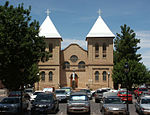First Battle of Mesilla
1861 in New Mexico TerritoryBattles of the American Civil War in New MexicoBattles of the Trans-Mississippi Theater of the American Civil WarConfederate occupation of New MexicoConfederate victories of the American Civil War ... and 3 more
History of Doña Ana County, New MexicoJuly 1861 eventsNew Mexico Territory

The First Battle of Mesilla, was fought on July 25, 1861 at Mesilla in New Mexico Territory, in present-day Doña Ana County, New Mexico. It was an engagement between Confederate and Union forces during the American Civil War. The battle resulted in a Confederate victory and led directly to the official establishing of a Confederate Arizona Territory, consisting of the southern portion of the New Mexico Territory. The victory paved the way for the Confederate New Mexico Campaign the following year.
Excerpt from the Wikipedia article First Battle of Mesilla (License: CC BY-SA 3.0, Authors, Images).First Battle of Mesilla
Calle del Oeste,
Geographical coordinates (GPS) Address Nearby Places Show on map
Geographical coordinates (GPS)
| Latitude | Longitude |
|---|---|
| N 32.27204 ° | E -106.80359 ° |
Address
Calle del Oeste
Calle del Oeste
88046
New Mexico, United States
Open on Google Maps





